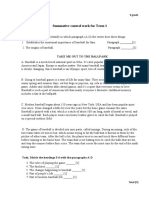B1 UNITS 1 and 2 CLIL
B1 UNITS 1 and 2 CLIL
Uploaded by
Xime OlariagaCopyright:
Available Formats
B1 UNITS 1 and 2 CLIL
B1 UNITS 1 and 2 CLIL
Uploaded by
Xime OlariagaCopyright
Available Formats
Share this document
Did you find this document useful?
Is this content inappropriate?
Copyright:
Available Formats
B1 UNITS 1 and 2 CLIL
B1 UNITS 1 and 2 CLIL
Uploaded by
Xime OlariagaCopyright:
Available Formats
CLIL B1 Units
Technology
1 Work with a partner. Look at the photos of 2 Quickly read the text. Which statement best describes
the animals and discuss this question: what it is about?
Why do you think there are fewer and fewer of a Introducing technology to increase the number of
these animals remaining in our world today? endangered animals in the wild
b Preventing the illegal sale of animal body parts
c Using new methods to track criminals who exploit wildlife
It is estimated that 100,000,000 sharks
are killed each year for their fins.
HOW TECHNOLOGY
IS HELPING THE FIGHT In the last three years,
AGAINST ANIMAL CRIME
poachers have killed about
100,000 elephants.
We don’t only come across crime in the human world, 3 In some parts of the world, robotic animals
a growing number of people are exploiting the are used to trick poachers. This method has
endangered wildlife of our planet too. They are known already worked for criminals hunting deer, and
as poachers or animal traffickers and their criminal perhaps it could prove successful to use robotic
activity is threatening the survival of more and more of elephants and tigers too.
our animal population.
4 The DNA analysis of illegal animal goods,
Poachers focus on capturing or killing animals with like elephant ivory or shark fins, helps
body parts that are worth a lot of money – tiger skins investigators locate where they come from, and
and bones, rhino horns, shark fins or ivory from this can bring them closer to finding out who
elephants – and they sell these items illegally. the criminals are, therefore protecting these
Fortunately, we now live in a world that is making animals in the future.
use of technology more than ever, and there are some
5 Mobile apps like WILDSCAN now exist
excellent high-tech methods used to look for these
to help investigators keep track of animal
criminals and help combat animal crime.
trafficking by providing photos and information
1 Some endangered animals wear smart collars on wildlife in danger.
to track their movements. These collars have a GPS
These methods of technology are all making
system inside that tells investigators where the animal
improvements in the hunt for poachers and
is at any time, and therefore helps keep it safe from
with plenty of other techniques also in use, one
traffickers.
day animal crime can hopefully be stopped
2 High-tech flying devices called drones are altogether.
increasingly used to cover large and remote regions and
can help locate criminals illegally hunting wildlife in
these areas.
This page has been downloaded from www.macmillangateway2.com
Photocopiable © Macmillan Publishers Limited 2016 1 of 2
CLIL B1 Units
3 Read the text again. Decide if the statements are PROJECT
True (T) or False (F).
1 Find out about another technology that is used to
1 A poacher is somebody who investigates help prevent animal crime. Describe the key features
a crime. T/F of the technology and how it works to protect
2 The increase in animal trafficking is wildlife. Present the information to the class.
resulting in more endangered wildlife. T/F 2 Research an endangered animal and include ways in
3 New technology methods are helping which technology is used to help protect the animal
criminals sell animal body parts illegally. T/F in the wild. Present the information to the class.
4 Some traffickers are using smart collars
to find out the location of animals. T/F
5 A robot of a tiger could be used in A VOCABULARY FOCUS
the future to help combat animal crime. T/F
combat [v]: fight, prevent
6 Investigators can use DNA analysis and mobile
endangered [adj]: when something risks disappearing
apps to collect more evidence on criminals. T/F
exploit [v]: treat somebody/something unfairly to
benefit others.
4 Write the correct method of technology. fin [n]: thin flat part sticking out from the body of a fish.
1 something an animal wears around its neck to keep high-tech [adj]: the most modern or advanced of
it safer: technology.
horn [n]: hard pointed part growing out of an animal’s
2 a device that can locate poachers from the sky: head.
illegal [adj]: not allowed
ivory [n]: the bone that an elephant’s tusks are made of.
3 investigators analyse this to find out where illegal
poacher [n]: somebody who illegally catches or kills
animal goods come from:
animals.
survival [n]: trying to live in very difficult conditions.
4 an animal that isn’t real:
threaten [v]: cause harm to somebody or something.
trafficker [n]: somebody who buys and sells things
illegally.
5 Work with a partner and discuss the questions.
1 How important do you think technology is in
protecting endangered animals?
2 In what way can satellite cameras help stop poaching?
?
? DID YOU KNOW?
?
Thanks to some technology tests using drones in
?
an important wildlife area in Kenya, poaching has
reduced by 96%.
The West African giraffe is a success story for
endangered animals – about 15 years ago there
were only 50 of them left in the world, but this has
increased to 200 today partly thanks to the use of
smart collars that some of the animals now wear to
protect them from poachers.
This page has been downloaded from www.macmillangateway2.com
Photocopiable © Macmillan Publishers Limited 2016 2 of 2
You might also like
- Together Klasa 5 SB Unit 1Document12 pagesTogether Klasa 5 SB Unit 1Adrianna BaranNo ratings yet
- B1 Preliminary For Schools Answer Sheet - ListeningDocument1 pageB1 Preliminary For Schools Answer Sheet - ListeningXime Olariaga67% (3)
- B1 Review Test 3 StandardDocument4 pagesB1 Review Test 3 StandardXime Olariaga100% (1)
- B1 Preliminary For Schools Answer Sheet - WritingDocument4 pagesB1 Preliminary For Schools Answer Sheet - WritingXime Olariaga60% (5)
- L&E Catalogue 2019-2021Document554 pagesL&E Catalogue 2019-2021nam nguyenNo ratings yet
- B1 Review Test 1 Answer Key StandardDocument2 pagesB1 Review Test 1 Answer Key StandardXime Olariaga100% (4)
- B1 End of Year Test Answer Key HigherDocument3 pagesB1 End of Year Test Answer Key HigherXime Olariaga100% (1)
- B1 Diagnostic Test Teacher's Guide and Answer KeyDocument3 pagesB1 Diagnostic Test Teacher's Guide and Answer KeyXime OlariagaNo ratings yet
- Schlumberger Field EngineerDocument4 pagesSchlumberger Field EngineerLiju Matt50% (2)
- Semester One Lesson Plan Islam Beliefs Gallery WalkDocument19 pagesSemester One Lesson Plan Islam Beliefs Gallery Walkapi-377843421100% (1)
- Strategic-Reading-Level-1 - Ecotourism - Jetlag PDFDocument6 pagesStrategic-Reading-Level-1 - Ecotourism - Jetlag PDFThanh TranNo ratings yet
- Level 6 HANDOUTTeacher Part 1Document29 pagesLevel 6 HANDOUTTeacher Part 1Aritz RománNo ratings yet
- B1 Review Test 3 Answer Key StandardDocument2 pagesB1 Review Test 3 Answer Key StandardXime OlariagaNo ratings yet
- B1 Review Test 1 HigherDocument6 pagesB1 Review Test 1 HigherXime Olariaga100% (2)
- B1 Diagnostic TestDocument6 pagesB1 Diagnostic TestXime Olariaga100% (1)
- B1 End of Year Test HigherDocument5 pagesB1 End of Year Test HigherXime OlariagaNo ratings yet
- B1 UNIT 5 Everyday EnglishDocument1 pageB1 UNIT 5 Everyday EnglishXime OlariagaNo ratings yet
- Preliminary For Schools Reading Candidate Answer Sheet: Instructions For Parts 1, 2, 3, 4 and 5Document2 pagesPreliminary For Schools Reading Candidate Answer Sheet: Instructions For Parts 1, 2, 3, 4 and 5Xime Olariaga100% (2)
- b1 Units 5 and 6 ClilDocument2 pagesb1 Units 5 and 6 ClilXime OlariagaNo ratings yet
- CBAPDocument7 pagesCBAPMearajANo ratings yet
- CLIL Science DU (MacMillan)Document16 pagesCLIL Science DU (MacMillan)Judith PérezNo ratings yet
- CLIL GameDocument3 pagesCLIL GameLarissa100% (1)
- Clil World Natural Sciences 6 Unit 1Document20 pagesClil World Natural Sciences 6 Unit 1montoyalarissa227No ratings yet
- A2 UNIT 1 Test Answer Key StandardDocument2 pagesA2 UNIT 1 Test Answer Key StandardMaxi Comas100% (1)
- B1 Extra Tasks For Early Finishers 2Document1 pageB1 Extra Tasks For Early Finishers 2hasimah5768No ratings yet
- Owi Bre l03 U03 Ak WorkbookDocument10 pagesOwi Bre l03 U03 Ak WorkbookRocío Olate100% (1)
- Unit - 5 - Assessment in CLILDocument15 pagesUnit - 5 - Assessment in CLILmrr107No ratings yet
- b1 Units 9 and 10 ClilDocument2 pagesb1 Units 9 and 10 ClilKerenNo ratings yet
- 2024 2026 SyllabusDocument33 pages2024 2026 SyllabusAhmad MotaizNo ratings yet
- Welcome To New Language LeaderDocument1 pageWelcome To New Language LeaderԳայանե ՄելքումյանNo ratings yet
- Life Vision Int Plus Vocab Worksheet A U5Document1 pageLife Vision Int Plus Vocab Worksheet A U5Ewelina NaczkNo ratings yet
- Units 1-2 Test ADocument4 pagesUnits 1-2 Test AAllisson CornejoNo ratings yet
- Sol3e Elem Progress Test Answer Key ADocument11 pagesSol3e Elem Progress Test Answer Key AfrasquiNo ratings yet
- Multiple IntelligencesDocument16 pagesMultiple IntelligencesPatricia E MartinNo ratings yet
- Life Vision Elem Comm Worksheet U4Document1 pageLife Vision Elem Comm Worksheet U4cooleugene64No ratings yet
- A2 UNIT 7 Flipped Classroom Video WorksheetDocument1 pageA2 UNIT 7 Flipped Classroom Video WorksheetvanessaNo ratings yet
- New Matrix Intermediate WB WWW Frenglish Ru KeysDocument7 pagesNew Matrix Intermediate WB WWW Frenglish Ru Keysr0m4inNo ratings yet
- Clil Lesson Method ScenariosDocument100 pagesClil Lesson Method ScenariosMariely AcevedoNo ratings yet
- МОДО тест 2022 18Document4 pagesМОДО тест 2022 18kubora0320No ratings yet
- NLL Adv Tnotes U12Document16 pagesNLL Adv Tnotes U12Xeno deCuirNo ratings yet
- Action - Non-Action Verbs PracticeDocument2 pagesAction - Non-Action Verbs PracticeFatihNo ratings yet
- A2 UNIT 5 Life Skills Teacher's NotesDocument1 pageA2 UNIT 5 Life Skills Teacher's NotesCarolinaNo ratings yet
- B1 UNITS 9 and 10 Literature Teacher's NotesDocument2 pagesB1 UNITS 9 and 10 Literature Teacher's NotesKerenNo ratings yet
- Telling A Story: Reading and Writing Portfolio 11Document2 pagesTelling A Story: Reading and Writing Portfolio 11William OrtizNo ratings yet
- Headway: Clil WorksheetsDocument2 pagesHeadway: Clil WorksheetsAmina VeladžićNo ratings yet
- B1 UNITS 1 and 2 CLIL Teacher's NotesDocument1 pageB1 UNITS 1 and 2 CLIL Teacher's NotesXime OlariagaNo ratings yet
- Higher-Order Thinking Skills in Language Teaching/learning: Penny Ur 2018 25th International IATEFL Slovenia ConferenceDocument60 pagesHigher-Order Thinking Skills in Language Teaching/learning: Penny Ur 2018 25th International IATEFL Slovenia ConferenceRafly PNo ratings yet
- OPT A2 U01 Grammar StandardDocument1 pageOPT A2 U01 Grammar StandardNicoleta MagalaNo ratings yet
- The Dark Side of Halloween American English StudentDocument5 pagesThe Dark Side of Halloween American English StudentKaiky CardosoNo ratings yet
- Speakout DVD Extra Elementary Unit 6Document1 pageSpeakout DVD Extra Elementary Unit 6Andrea La Chira GutierrezNo ratings yet
- (UNITS 7-12) : End of Course AssessmentDocument6 pages(UNITS 7-12) : End of Course AssessmentSkkkl KkkklNo ratings yet
- A1+ Review Test 2 Answer Key HigherDocument2 pagesA1+ Review Test 2 Answer Key HigherLUISA CASTRO CUNEONo ratings yet
- Teacher's Guide. Unit 5 PDFDocument18 pagesTeacher's Guide. Unit 5 PDFMar Pastrana VioqueNo ratings yet
- The Cambridge Guide To Second Language TDocument7 pagesThe Cambridge Guide To Second Language TRolando ValenciaNo ratings yet
- CLIL Magazine Spring 2014 PDFDocument20 pagesCLIL Magazine Spring 2014 PDFAngelMolinaNo ratings yet
- Practice Test A June 2020 PDFDocument4 pagesPractice Test A June 2020 PDFManzana ManzanaNo ratings yet
- GI B2 U3 Test Standard AKDocument2 pagesGI B2 U3 Test Standard AKLorena Gil LladróNo ratings yet
- English Placement Test A2 B1Document4 pagesEnglish Placement Test A2 B1Mohannad IsamNo ratings yet
- English Quest 1 - Explanation and ExamplesDocument25 pagesEnglish Quest 1 - Explanation and ExamplesOlgaNo ratings yet
- Assessment in ClilDocument11 pagesAssessment in ClilIryna ArkhipovaNo ratings yet
- Mid-Term Test B1.2Document4 pagesMid-Term Test B1.2Modern HouseNo ratings yet
- B1 U3 Exam Practice ReadingDocument2 pagesB1 U3 Exam Practice ReadingNickNo ratings yet
- Harmonize ST TRM Reading Unit 1 WorksheetsDocument3 pagesHarmonize ST TRM Reading Unit 1 WorksheetsTamaraNo ratings yet
- FCE Reading and Use of English Practice Test 5 Printable: New Cycling SchemesDocument9 pagesFCE Reading and Use of English Practice Test 5 Printable: New Cycling SchemesVicky Julianne YoveraNo ratings yet
- Placement Test Elementary To Intermediate: Interpreting ScoresDocument4 pagesPlacement Test Elementary To Intermediate: Interpreting ScoresTấn Linh NguyễnNo ratings yet
- Tenses Board GameDocument2 pagesTenses Board GamerenatajazminjNo ratings yet
- Art and Passive: 1. Choose The Correct AnswersDocument1 pageArt and Passive: 1. Choose The Correct AnswersAnderson Cadena100% (1)
- Q1-WEEK1-Materials Found in The Environment (Farming Chemicals, Reagents)Document29 pagesQ1-WEEK1-Materials Found in The Environment (Farming Chemicals, Reagents)majoanmae.magnoNo ratings yet
- A2 UNIT 4 Test Answer Key HigherDocument2 pagesA2 UNIT 4 Test Answer Key HigherMaxi ComasNo ratings yet
- Telling The TimeDocument2 pagesTelling The Timejuadavar100% (1)
- Summative Control Work For Term 1: ReadingDocument6 pagesSummative Control Work For Term 1: ReadingSauleNo ratings yet
- A2 Achievement Test - Hernan EscamillaDocument25 pagesA2 Achievement Test - Hernan EscamillaHernan Escamilla SanchezNo ratings yet
- Od2e l5 Entry TestDocument4 pagesOd2e l5 Entry Testnoo naNo ratings yet
- Endangered AnimalsDocument27 pagesEndangered AnimalsMarilena GündüzNo ratings yet
- Robo-Biotics Argumentive Thesis Final DraftDocument12 pagesRobo-Biotics Argumentive Thesis Final Draftapi-408243037No ratings yet
- Evidence: The Cross River GorillaDocument4 pagesEvidence: The Cross River GorillaCarlos Fabian MesaNo ratings yet
- B1 Unit, Review and End of Year Test AudioscriptDocument6 pagesB1 Unit, Review and End of Year Test AudioscriptXime OlariagaNo ratings yet
- Review Tests 3 - HLDocument5 pagesReview Tests 3 - HLanisalera150750% (2)
- B1 Review Test 2 Answer Key StandardDocument2 pagesB1 Review Test 2 Answer Key StandardXime Olariaga100% (1)
- B1 Review Test 1 Answer Key StandardDocument2 pagesB1 Review Test 1 Answer Key StandardXime OlariagaNo ratings yet
- Review Tests 1 - HL - KeyDocument2 pagesReview Tests 1 - HL - Keyanisalera1507No ratings yet
- Review Tests 1 - SLDocument5 pagesReview Tests 1 - SLanisalera1507No ratings yet
- B1 End of Year Test Answer Key StandardDocument2 pagesB1 End of Year Test Answer Key StandardXime Olariaga40% (5)
- B1 End of Year Test StandardDocument7 pagesB1 End of Year Test StandardXime OlariagaNo ratings yet
- B1 End of Year Test Answer Key HigherDocument3 pagesB1 End of Year Test Answer Key HigherXime OlariagaNo ratings yet
- B1 UNITS 5 and 6 Study SkillsDocument1 pageB1 UNITS 5 and 6 Study SkillsXime OlariagaNo ratings yet
- AlarmSense Installation GuideDocument4 pagesAlarmSense Installation Guideadam rejamNo ratings yet
- 9FM0 Topic Test - CP - 1 - Proof by Induction MS PDFDocument15 pages9FM0 Topic Test - CP - 1 - Proof by Induction MS PDFpriyahaasinigantiNo ratings yet
- Niko Wolf Was Germany Ever United 2008Document59 pagesNiko Wolf Was Germany Ever United 2008Ronan LyonsNo ratings yet
- Midterm Exam in Fire Technology and Arson InvestigationDocument4 pagesMidterm Exam in Fire Technology and Arson InvestigationGilbert MalabugNo ratings yet
- Material de InglesPDFDocument3 pagesMaterial de InglesPDFjambajungoNo ratings yet
- Booklist Y8: Pakistan International School Jeddah - English Section Academic Session 2020-2021Document1 pageBooklist Y8: Pakistan International School Jeddah - English Section Academic Session 2020-2021FAREEDNo ratings yet
- DAFTAR PUSTAKA-Shahnaz Dwi Permata Putri-G1G014033-Skripsi-2018Document5 pagesDAFTAR PUSTAKA-Shahnaz Dwi Permata Putri-G1G014033-Skripsi-2018nintendo anjayNo ratings yet
- Vessel Take Over ReportDocument26 pagesVessel Take Over Reportolegmartynov90No ratings yet
- Care of Older Adult in Chronic ConfusionDocument7 pagesCare of Older Adult in Chronic ConfusionClaire MachicaNo ratings yet
- Rotational Kinematics Guided Reading KeyDocument3 pagesRotational Kinematics Guided Reading KeyR Jay LagdaminNo ratings yet
- EET307 M5 - Ktunotes - inDocument33 pagesEET307 M5 - Ktunotes - insjthirtysixNo ratings yet
- Case Study 1Document7 pagesCase Study 1Muhammad Atif100% (1)
- Information Systems, Organizations, and Strategy: Slides Prepared by MAKS, MIS Department, DUDocument50 pagesInformation Systems, Organizations, and Strategy: Slides Prepared by MAKS, MIS Department, DUSP VetNo ratings yet
- 50 NiftDocument91 pages50 Niftpossess1289No ratings yet
- NMK10603 - Chapter 4 - Functions - Part 2Document22 pagesNMK10603 - Chapter 4 - Functions - Part 2MOHAMMAD SAAID SHARUZQIE BIN SAARI STUDENTNo ratings yet
- Grade 10 Third Quarter Test QuestionDocument2 pagesGrade 10 Third Quarter Test Questionjhun bagain75% (4)
- 0417 s13 QP 12 PDFDocument16 pages0417 s13 QP 12 PDFjainishpatel17No ratings yet
- Cybersecurity WorldDocument20 pagesCybersecurity WorldNida malantawanNo ratings yet
- The Dark Remains Chapter SamplerDocument23 pagesThe Dark Remains Chapter SamplerAllen & UnwinNo ratings yet
- GAHH Install Instructions Z3 96-02Document35 pagesGAHH Install Instructions Z3 96-02Medo O. EzzatNo ratings yet
- Unit II Lecture 1 Measurement of DistancesDocument31 pagesUnit II Lecture 1 Measurement of Distanceskusjariar.18No ratings yet
- Physics Investigatory Project Final 2Document12 pagesPhysics Investigatory Project Final 2Dheeraj KumarNo ratings yet
- KUD Chart - Know Understand DoDocument4 pagesKUD Chart - Know Understand DoArjess ValenciaNo ratings yet
- CBRN 4 Chem PDFDocument1 pageCBRN 4 Chem PDFxjmnNo ratings yet
- Numinous Spaces in Gothic, Manuel AguirreDocument18 pagesNuminous Spaces in Gothic, Manuel AguirreLuke NixonNo ratings yet
- Egorov ArtemDocument38 pagesEgorov ArtemAndrei MartinasNo ratings yet
















































































































